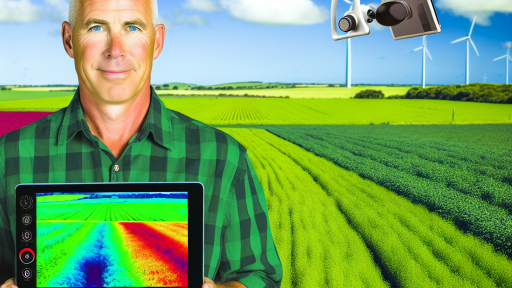Understanding the Role of Social Media in Agribusiness Marketing
The Growing Influence of Social Media
Social media has transformed communication in agribusiness.
Farmers and agribusinesses can now reach wider audiences.
Platforms like Facebook, Twitter, and Instagram foster connections.
These channels enable real-time engagement with consumers.
Consequently, social media builds community around agricultural products.
Benefits of Social Media Marketing
Social media marketing offers numerous advantages.
First, it enhances brand visibility and recognition.
Furthermore, it allows businesses to showcase products creatively.
By sharing videos and images, companies can attract attention.
Additionally, social media facilitates customer interaction and feedback.
This engagement can lead to improved customer loyalty over time.
Targeting the Right Audience
Identifying the target audience is crucial for success.
Agribusinesses must understand their customers’ demographics.
By analyzing social media data, businesses can tailor their content.
This customization ensures messages resonate with potential customers.
Transform Your Agribusiness
Unlock your farm's potential with expert advice tailored to your needs. Get actionable steps that drive real results.
Get StartedMoreover, targeted ads can effectively reach specific groups.
Leveraging Influencers in Agribusiness
Influencer marketing has become a pivotal strategy.
Collaborating with influencers increases credibility and reach.
These partnerships can introduce products to new audiences.
Authenticity is key; choose influencers who align with values.
Engagement with the right influencers enhances brand awareness.
Measuring Success Through Analytics
Analytic tools provide insights into social media performance.
Tracking engagement metrics reveals what resonates with audiences.
Furthermore, regular analysis allows for strategy adjustments.
This ongoing evaluation improves marketing efforts over time.
Setting clear goals is essential for measuring success.
Building Content Strategy
Developing a robust content strategy is vital.
Scheduling posts and maintaining consistency is essential.
Utilize diverse content types, including blogs, videos, and images.
This variety keeps the audience engaged and informed.
Furthermore, educational content can position brands as industry leaders.
Responding to Trends and Feedback
Staying updated with industry trends is critical.
Social media allows for quick responses to market changes.
Listening to customer feedback helps improve products and services.
Incorporating feedback fosters trust and strengthens relationships.
Adaptation is key to remaining relevant in a dynamic market.
Identifying the Right Social Media Platforms for Agricultural Businesses
Understanding Your Target Audience
Identifying your target audience is crucial for effective marketing.
Consider their demographics, interests, and preferences.
Analyze where they spend their time online.
Showcase Your Farming Business
Publish your professional farming services profile on our blog for a one-time fee of $200 and reach a dedicated audience of farmers and agribusiness owners.
Publish Your ProfileThis data will guide your platform selection.
Evaluating Popular Social Media Platforms
Facebook is a versatile platform for reaching a broad audience.
Its advertising tools help target specific demographics effectively.
Instagram focuses on visual content and can showcase products attractively.
This platform is ideal for sharing high-quality images and videos.
Twitter is great for real-time updates and engaging conversations.
It allows for quick interactions and feedback from customers.
YouTube excels for demonstrating agricultural practices through video.
This platform offers a way to educate your audience while showcasing your expertise.
Choosing Niche Platforms
LinkedIn is optimal for B2B connections within agribusiness.
This platform can help you network with industry professionals.
Consider platforms like Pinterest for sharing visual ideas related to farming.
This is particularly useful for gardening tips or DIY projects.
Assessing Content Types
Your content must align with the platform’s strengths.
Visual platforms benefit from attractive imagery and videos.
Conversely, text-heavy content works well on platforms like LinkedIn.
Prepare different content types based on your chosen platforms.
Testing and Analyzing Results
Conduct small-scale tests on various platforms to analyze engagement.
Utilize analytics tools to track performance metrics.
This data will help you adjust your strategy over time.
Be flexible and willing to pivot if necessary.
Creating Compelling Content
Understanding Your Audience
First, identify your target market.
Different segments have distinct needs and preferences.
Research their interests and behaviors online.
This knowledge helps you tailor your content effectively.
Utilizing Visual Elements
Visual content captures attention quickly.
Use high-quality images and videos relevant to your brand.
Infographics can simplify complex information effectively.
Also, consider using user-generated content to enhance authenticity.
Crafting Engaging Stories
Tell stories that resonate with your audience.
Share narratives from real farmers and customers.
Highlight challenges, successes, and heartfelt experiences.
Compelling stories foster emotional connections with your brand.
Leveraging Social Proof
Showcase customer testimonials and reviews.
Highlight case studies that demonstrate your brand’s impact.
Social proof increases credibility and trustworthiness.
Use these elements across your social media platforms.
Including Calls to Action
Every piece of content should guide your audience.
Include clear calls to action (CTAs) in your posts.
Encourage users to share, comment, or visit your website.
Showcase Your Farming Business
Publish your professional farming services profile on our blog for a one-time fee of $200 and reach a dedicated audience of farmers and agribusiness owners.
Publish Your ProfileEffective CTAs lead to increased engagement and conversions.
Maintaining Consistency
Consistency builds brand recognition.
Establish a posting schedule that suits your audience.
Ensure your messaging aligns across all platforms.
This approach helps reinforce your brand identity.
Delve into the Subject: Building Successful Partnerships In Agriculture Today
Engaging Your Audience
Strategies for Effective Interaction
Engaging your audience on social media is essential for agribusiness success.
Start by identifying your target audience clearly.
Next, tailor your content to meet their interests and needs.
Use high-quality visuals to capture attention quickly.
Additionally, consider incorporating videos that showcase your products.
Videos can effectively illustrate processes and tell your brand’s story.
Encourage participation by asking open-ended questions.
This approach invites followers to share their opinions and experiences.
Create engaging polls to gather insights while keeping your audience involved.
Show your personality through relatable and authentic content.
For example, share behind-the-scenes glimpses of your operations.
Another strategy includes sharing user-generated content.
This highlights customer experiences and builds community trust.
Respond promptly to comments and messages to foster connection.
Timely interactions reinforce the importance of your audience’s input.
Host live Q&A sessions to address your audience’s questions directly.
These sessions can significantly boost engagement and trust.
Collaborate with influencers in the agribusiness sector.
Influencers can help broaden your reach and credibility.
Finally, analyze engagement metrics to refine your strategies.
Use these insights to improve content and interaction techniques.
Find Out More: Creating a Legacy with Farm Succession Planning
Utilizing Visual Content
The Impact of Visuals on Engagement
Visual content significantly boosts engagement in agribusiness marketing.
Images and videos create a connection with your audience.
Moreover, they convey complex information quickly and effectively.
Enhancing Brand Storytelling
Visuals enhance your brand storytelling in agribusiness.
High-quality images showcase your products and their origins.
Videos can bring your farming practices to life, demonstrating authenticity.
Building Trust and Credibility
Trust plays a vital role in consumer decisions.
Authentic imagery can boost your brand’s credibility.
Consumers prefer to connect with real stories and real faces.
Types of Visual Content to Incorporate
Incorporate various types of visual content into your marketing strategy.
- High-resolution images of crops and products.
- Behind-the-scenes videos showcasing daily operations.
- Infographics illustrating agricultural processes.
Utilizing these types will engage your audience more effectively.
Utilizing User-Generated Content
User-generated content offers a fresh perspective.
Showcase Your Farming Business
Publish your professional farming services profile on our blog for a one-time fee of $200 and reach a dedicated audience of farmers and agribusiness owners.
Publish Your ProfileShowcase images and videos from customers using your products.
This strategy fosters community engagement and loyalty.
Leveraging Social Media Platforms
Different platforms support various types of visuals.
Instagram is ideal for eye-catching images and reels.
Facebook allows for longer videos and storytelling.
Understanding these dynamics will optimize your reach.
Measuring Visual Content Success
Track the performance of your visual content regularly.
Engagement metrics provide insight into what works best.
Adjust your strategy based on these findings to maximize impact.
You Might Also Like: Health Insurance Options for Farming Families

Case Studies: Successful Social Media Campaigns in the Agribusiness Sector
Case Study: Fresh Greens Farm
Fresh Greens Farm launched an Instagram campaign highlighting their organic produce.
They showcased beautiful photos of their vegetables and herbs.
This visually appealing content attracted a younger audience.
As a result, their follower count increased by 50% in three months.
Moreover, they reported a 30% boost in sales from Instagram referrals.
Case Study: Meadow Valley Dairy
Meadow Valley Dairy utilized Facebook to connect with local consumers.
They shared educational videos about dairy farming practices.
These videos addressed common misconceptions about dairy production.
Engaging content encouraged discussion among viewers.
Their page likes grew by 40%, increasing community trust.
Case Study: Harvest Home Co-op
Harvest Home Co-op developed a Twitter strategy centered on local events.
They tweeted live updates during farmers’ markets and community festivals.
This real-time engagement created excitement among followers.
The strategy led to their events seeing a 25% increase in attendance.
Consequently, sales during these events also spiked significantly.
Case Study: Pure Bees Honey Inc.
Pure Bees Honey Inc. integrated storytelling into their social media approach.
They shared the journey of beekeeping and honey production.
Story-driven posts resonated well with their audience.
As a result, customer engagement soared on all platforms.
Furthermore, their honey sales doubled within six months.
Case Study: Green Valley Farms
Green Valley Farms focused on creating infographics for educational purposes.
These infographics detailed the benefits of sustainable farming.
They encouraged sharing, resulting in increased visibility.
This method not only informed the public but also attracted new followers.
Ultimately, their online community expanded and engagement levels rose.
Common Strategies Across Successful Campaigns
Successful agribusiness campaigns often use visual content effectively.
Engagement through educational materials builds trust with consumers.
Additionally, real-time updates keep followers interested and involved.
Moreover, storytelling connects emotionally with the audience.
By implementing these strategies, agribusinesses can thrive on social media.
Showcase Your Farming Business
Publish your professional farming services profile on our blog for a one-time fee of $200 and reach a dedicated audience of farmers and agribusiness owners.
Publish Your ProfileExplore Further: Mobile Technology Trends in Agribusiness Management
Measuring Success: Key Metrics for Evaluating Social Media Marketing Efforts
Engagement Metrics
Engagement rates help you understand audience interaction.
Consider likes, shares, and comments as primary indicators.
Monitor these metrics to gauge content effectiveness.
Higher engagement often correlates with increased brand awareness.
Reach and Impressions
Reach indicates how many unique users see your content.
Impressions measure how often your content is displayed.
Both metrics are essential for assessing visibility.
Growing reach can lead to more opportunities for engagement.
Follower Growth
Tracking follower growth shows your audience expansion.
Analyze trends over time to identify spikes or declines.
Implement strategies to maintain steady growth.
Engaging content typically drives higher follower rates.
Conversion Rates
Conversion rates reveal how effectively you drive actions.
Define specific actions, such as purchases or sign-ups.
Measure conversions against your overall traffic sources.
Effective content should lead to higher conversion rates.
Referral Traffic
Referral traffic indicates how users find your website via social media.
Use analytics tools to track referral sources accurately.
This metric allows you to evaluate the effectiveness of campaigns.
A high level of referral traffic suggests successful outreach.
Sentiment Analysis
Sentiment analysis provides insights into public perception.
Analyze comments and mentions for positive or negative tones.
This feedback influences your brand image and reputation.
Adjust your strategy based on audience sentiment.
Cost-Effectiveness
Calculate cost-per-click (CPC) and return on investment (ROI).
Evaluating these metrics determines marketing efficiency.
Seek to optimize spending while maximizing results.
A cost-effective approach drives sustainable growth.
Future Trends: Innovations in Social Media Marketing for Agribusiness
Emergence of New Platforms
New social media platforms are continually emerging.
These platforms offer unique opportunities for agribusiness marketing.
On platforms like TikTok, engaging video content thrives.
Marketers can showcase innovative farming techniques effectively.
AI-Driven Marketing Strategies
Artificial intelligence is transforming social media marketing.
AI tools help in data analysis for targeted campaigns.
This results in personalized content that resonates with consumers.
Moreover, automation can enhance ad placements and tracking.
Influencer Marketing Trends
The rise of micro-influencers is noteworthy.
These individuals have dedicated audiences in niche markets.
Collaborating with local influencers can boost authenticity.
Showcase Your Farming Business
Publish your professional farming services profile on our blog for a one-time fee of $200 and reach a dedicated audience of farmers and agribusiness owners.
Publish Your ProfileThis strategy enables brands to connect on a personal level.
Content Innovation and Storytelling
Compelling storytelling is central to effective marketing.
Brands can share their journey and values transparently.
This approach builds trust and loyalty with consumers.
Visual content, such as infographics and videos, enhances engagement.
Interactive Content Engagement
Interactive content, such as polls and quizzes, gains traction.
This type of content encourages user participation.
As a result, agribusinesses can gather valuable insights.
Furthermore, it fosters community and connection with the audience.
Emphasis on Sustainability
Sustainability is increasingly vital in consumer choices.
Agribusinesses can highlight sustainable practices on social media.
Transparency about sourcing and production builds credibility.
Consumers are more likely to support brands with eco-friendly initiatives.
Additional Resources
10 Tips for Farm Social Media | Land-Grant Press
7 Key Strategies for Effective Agribusiness Content Marketing …




